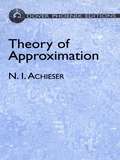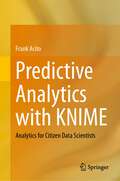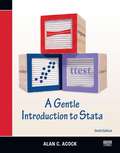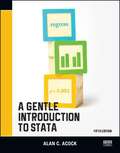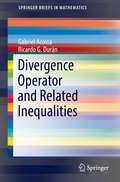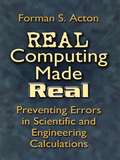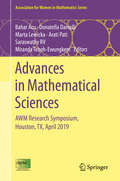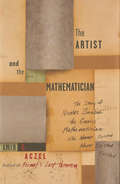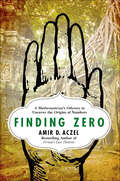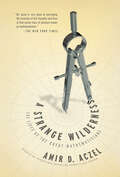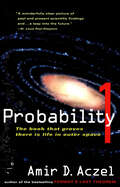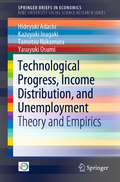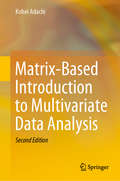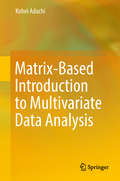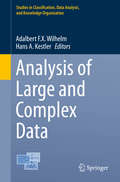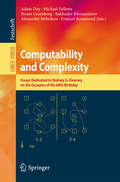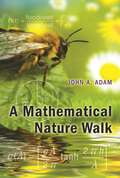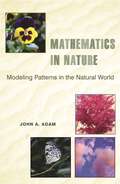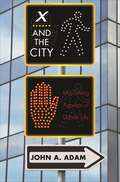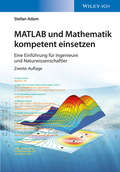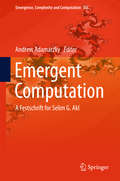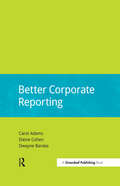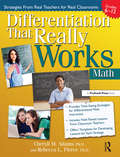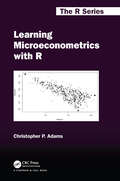- Table View
- List View
Theory of Approximation (Dover Books on Mathematics)
by N. I. AchieserA pioneer of many modern developments in approximation theory, N. I. Achieser designed this graduate-level text from the standpoint of functional analysis. The first two chapters address approximation problems in linear normalized spaces and the ideas of P. L. Tchebysheff. Chapter III examines the elements of harmonic analysis, and Chapter IV, integral transcendental functions of the exponential type. The final two chapters explore the best harmonic approximation of functions and Wiener's theorem on approximation. Professor Achieser concludes this exemplary text with an extensive section of problems and applications (elementary extremal problems, Szego's theorem, the Carathéodory-Fejér problem, and more).
Predictive Analytics with KNIME: Analytics for Citizen Data Scientists
by Frank AcitoThis book is about data analytics, including problem definition, data preparation, and data analysis. A variety of techniques (e.g., regression, logistic regression, cluster analysis, neural nets, decision trees, and others) are covered with conceptual background as well as demonstrations of KNIME using each tool. The book uses KNIME, which is a comprehensive, open-source software tool for analytics that does not require coding but instead uses an intuitive drag-and-drop workflow to create a network of connected nodes on an interactive canvas. KNIME workflows provide graphic representations of each step taken in analyses, making the analyses self-documenting. The graphical documentation makes it easy to reproduce analyses, as well as to communicate methods and results to others. Integration with R is also available in KNIME, and several examples using R nodes in a KNIME workflow are demonstrated for special functions and tools not explicitly included in KNIME.
A Gentle Introduction To Stata
by Alan C. AcockAcock assumes that the user is not familiar with any statistical software. This assumption of a blank slate is central to the structure and contents of the book. Acock starts with the basics; for example, the part of the book that deals with data management begins with a careful and detailed example of turning survey data on paper into a Stata-ready dataset on the computer. When explaining how to go about basic exploratory statistical procedures, Acock includes notes that will help the reader develop good work habits. This mixture of explaining good Stata habits and good statistical habits continues throughout the book.
A Gentle Introduction To Stata (Fifth Edition)
by Alan C. AcockAlan C. Acock's A Gentle Introduction to Stata, Fifth Edition, is aimed at new Stata users who want to become proficient in Stata. After reading this introductory text, new users will be able not only to use Stata well but also to learn new aspects of Stata. Acock assumes that the user is not familiar with any statistical software. This assumption of a blank slate is central to the structure and contents of the book. Acock starts with the basics; for example, the portion of the book that deals with data management begins with a careful and detailed example of turning survey data on paper into a Stata-ready dataset on the computer. When explaining how to go about basic exploratory statistical procedures, Acock includes notes that will help the reader develop good work habits. This mixture of explaining good Stata habits and good statistical habits continues throughout the book. Acock is quite careful to teach the reader all aspects of using Stata. He covers data management, good work habits (including the use of basic do-files), basic exploratory statistics (including graphical displays), and analyses using the standard array of basic statistical tools (correlation, linear and logistic regression, and parametric and nonparametric tests of location and dispersion). He also successfully introduces some more advanced topics such as multiple imputation and structural equation modeling in a very approachable manner. Acock teaches Stata commands by using the menus and dialog boxes while still stressing the value of do-files. In this way, he ensures that all types of users can build good work habits. Each chapter has exercises that the motivated reader can use to reinforce the material. The tone of the book is friendly and conversational without ever being glib or condescending. Important asides and notes about terminology are set off in boxes, which makes the text easy to read without any convoluted twists or forward-referencing. Rather than splitting topics by their Stata implementation, Acock arranges the topics as they would appear in a basic statistics textbook; graphics and postestimation are woven into the material in a natural fashion. Real datasets, such as the General Social Surveysfrom 2002 and 2006, are used throughout the book. The focus of the book is especially helpful for those in the behavioral and social sciences because the presentation of basic statistical modeling is supplemented with discussions of effect sizes and standardized coefficients. Various selection criteria, such as semipartial correlations, are discussed for model selection. Acock also covers a variety of commands available for evaluating reliability and validity of measurements. The fifth edition of the book includes two new chapters that cover multilevel modeling and item response theory (IRT) models. The multilevel modeling chapter demonstrates how to fit linear multilevel models using the mixedcommand. Acock discusses models with both random intercepts and random coefficients, and he provides a variety of examples that apply these models to longitudinal data. The IRT chapter introduces the use of IRT models for evaluating a set of items designed to measure a specific trait such as an attitude, value, or a belief. Acock shows how to use the irt suite of commands, which are new in Stata 14, to fit IRT models and to graph the results. In addition, he presents a measure of reliability that can be computed when using IRT.
Divergence Operator and Related Inequalities
by Gabriel Acosta Ricardo G. DuránThis Brief is mainly devoted to two classical and related results: the existence of a right inverse of the divergence operator and the so-called Korn Inequalities. It is well known that both results are fundamental tools in the analysis of some classic differential equations, particularly in those arising in fluid dynamics and elasticity. Several connections between these two topics and improved Poincar#65533; inequalities are extensively treated. From simple key ideas the book is growing smoothly in complexity. Beginning with the study of these problems on star-shaped domains the arguments are extended first to John domains and then to H#65533;lder α domains where the need of weighted spaces arises naturally. In this fashion, the authors succeed in presenting in an unified and concise way several classic and recent developments in the field. These features certainly makes this Brief useful for students, post-graduate students, and researchers as well.
Real Computing Made Real: Preventing Errors in Scientific and Engineering Calculations
by Forman S. ActonEngineers and scientists who want to avoid insidious errors in their computer-assisted calculations will welcome this concise guide to trouble-shooting. Real Computing Made Real offers practical advice on detecting and removing bugs. It also outlines techniques for preserving significant figures, avoiding extraneous solutions, and finding efficient iterative processes for solving nonlinear equations.Those who compute with real numbers (for example, floating-point numbers stored with limited precision) tend to develop techniques that increase the frequency of useful answers. But although there might be ample guidance for those addressing linear problems, little help awaits those negotiating the nonlinear world. This book, geared toward upper-level undergraduates and graduate students, helps rectify that imbalance. Its examples and exercises (with answers) help readers develop problem-formulating skills and assist them in avoiding the common pitfalls that software packages seldom detect. Some experience with standard numerical methods is assumed, but beginners will find this volume a highly practical introduction, particularly in its treatment of often-overlooked topics.
Advances in Mathematical Sciences: AWM Research Symposium, Houston, TX, April 2019 (Association for Women in Mathematics Series #21)
by Bahar Acu Donatella Danielli Marta Lewicka Arati Pati Saraswathy Rv Miranda Teboh-EwungkemThis volume highlights the mathematical research presented at the 2019 Association for Women in Mathematics (AWM) Research Symposium held at Rice University, April 6-7, 2019. The symposium showcased research from women across the mathematical sciences working in academia, government, and industry, as well as featured women across the career spectrum: undergraduates, graduate students, postdocs, and professionals. The book is divided into eight parts, opening with a plenary talk and followed by a combination of research paper contributions and survey papers in the different areas of mathematics represented at the symposium: algebraic combinatorics and graph theory algebraic biologycommutative algebraanalysis, probability, and PDEstopologyapplied mathematicsmathematics education
The Artist and the Mathematician
by Amir AczelNicolas Bourbaki, whose mathematical publications began to appear in the late 1930s and continued to be published through most of the twentieth century, was a direct product as well as a major force behind an important revolution that took place in the early decades of the twentieth century that completely changed Western culture. Pure mathematics, the area of Bourbaki's work, seems on the surface to be an abstract field of human study with no direct connection with the real world. In reality, however, it is closely intertwined with the general culture that surrounds it. Major developments in mathematics have often followed important trends in popular culture; developments in mathematics have acted as harbingers of change in the surrounding human culture. The seeds of change, the beginnings of the revolution that swept the Western world in the early decades of the twentieth century -- both in mathematics and in other areas -- were sown late in the previous century. This is the story both of Bourbaki and the world that created him in that time. It is the story of an elaborate intellectual joke -- because Bourbaki, one of the foremost mathematicians of his day -- never existed.
Finding Zero: A Mathematician's Odyssey to Uncover the Origins of Numbers
by Amir D. AczelThe invention of numerals is perhaps the greatest abstraction the human mind has ever created. Virtually everything in our lives is digital, numerical, or quantified. The story of how and where we got these numerals, which we so depend on, has for thousands of years been shrouded in mystery. Finding Zero is an adventure filled saga of Amir Aczel's lifelong obsession: to find the original sources of our numerals. Aczel has doggedly crisscrossed the ancient world, scouring dusty, moldy texts, cross examining so-called scholars who offered wildly differing sets of facts, and ultimately penetrating deep into a Cambodian jungle to find a definitive proof. Here, he takes the reader along for the ride. The history begins with the early Babylonian cuneiform numbers, followed by the later Greek and Roman letter numerals. Then Aczel asks the key question: where do the numbers we use today, the so-called Hindu-Arabic numerals, come from? It is this search that leads him to explore uncharted territory, to go on a grand quest into India, Thailand, Laos, Vietnam, and ultimately into the wilds of Cambodia. There he is blown away to find the earliest zero—the keystone of our entire system of numbers—on a crumbling, vine-covered wall of a seventh-century temple adorned with eaten-away erotic sculptures. While on this odyssey, Aczel meets a host of fascinating characters: academics in search of truth, jungle trekkers looking for adventure, surprisingly honest politicians, shameless smugglers, and treacherous archaeological thieves—who finally reveal where our numbers come from.
The Mystery of the Aleph
by Amir D. AczelThe history of infinity emphasizing the people who were interested in the concept. Stresses philosophical and religious importance of mathematical ideas throughout history. Fascinating even if math is not your strong suit.
A Strange Wilderness: The Lives of the Great Mathematicians
by Amir D. AczelThe international bestselling author of Fermat&’s Last Theorem explores the eccentric lives of history&’s foremost mathematicians. From Archimedes&’s eureka moment to Alexander Grothendieck&’s seclusion in the Pyrenees, bestselling author Amir Aczel selects the most compelling stories in the history of mathematics, creating a colorful narrative that explores the quirky personalities behind some of the most groundbreaking, influential, and enduring theorems. Alongside revolutionary innovations are incredible tales of duels, battlefield heroism, flamboyant arrogance, pranks, secret societies, imprisonment, feuds, and theft—as well as some costly errors of judgment that prove genius doesn&’t equal street smarts. Aczel&’s colorful and enlightening profiles offer readers a newfound appreciation for the tenacity, complexity, eccentricity, and brilliance of our greatest mathematicians.
Probability 1
by D. AczelFor thousands of years, it was the visionaries and writers who argued that we cannot be alone-that there is intellegent life in the universe. Now, with the discoveries of the Hubble Telescope, data emerging from Mars, and knowledge about life at the extremes, scientists are taking up where they left off. Amir Aczel, author of Fermat's Last Theorem, pulls together everyting science has discovered, and mixes in proabability theory, to argure the case for the existence of intelligent life beyond this planet. Probability 1 is an extraordinary tour de force in which the author draws on cosmology, math, and biology to tell the rollicking good story of scientists tackling important scientific questions that help answer this fundamental question. What is the probability of intelligent life in the universe? Read this book, and you'll be convinced, by the power of the argument and the excitement of the science.
Technological Progress, Income Distribution, and Unemployment: Theory and Empirics (SpringerBriefs in Economics)
by Hideyuki Adachi Kazuyuki Inagaki Tamotsu Nakamura Yasuyuki OsumiThis volume develops original methods of analyzing biased technological progress in the theory and empirics of economic growth and income distribution. Motivated by sharp increases in wage and income inequalities in the world since the beginning of the new century, many macroeconomists have begun to realize the importance of biased technological changes. However, the comprehensive explanations have not yet appeared. This volume analyzes the effects of factor-biased technological progress on growth and income distribution and shows that long-run trends of the capital-income ratio and capital share of income consistent with Piketty’s 2014 empirical results emerge. Incorporating the modified version of induced innovation theory into the standard neoclassical growth model, it also explains the long-run fluctuations of growth and income distribution consistent with the data shown in Piketty. Introducing a wage-setting function, the neoclassical growth model is modified to account for unemployment as well as to examine the dynamics of unemployment and the labor share of income under biased technological progress. Applying a new econometric method to Japanese industrial data, the authors test the key assumptions employed and important results derived in the theoretical part of this book.
Matrix-Based Introduction to Multivariate Data Analysis
by Kohei AdachiThis is the first textbook that allows readers who may be unfamiliar with matrices to understand a variety of multivariate analysis procedures in matrix forms. By explaining which models underlie particular procedures and what objective function is optimized to fit the model to the data, it enables readers to rapidly comprehend multivariate data analysis. Arranged so that readers can intuitively grasp the purposes for which multivariate analysis procedures are used, the book also offers clear explanations of those purposes, with numerical examples preceding the mathematical descriptions.Supporting the modern matrix formulations by highlighting singular value decomposition among theorems in matrix algebra, this book is useful for undergraduate students who have already learned introductory statistics, as well as for graduate students and researchers who are not familiar with matrix-intensive formulations of multivariate data analysis.The book begins by explaining fundamental matrix operations and the matrix expressions of elementary statistics. Then, it offers an introduction to popular multivariate procedures, with each chapter featuring increasing advanced levels of matrix algebra. Further the book includes in six chapters on advanced procedures, covering advanced matrix operations and recently proposed multivariate procedures, such as sparse estimation, together with a clear explication of the differences between principal components and factor analyses solutions. In a nutshell, this book allows readers to gain an understanding of the latest developments in multivariate data science.
Matrix-Based Introduction to Multivariate Data Analysis
by Kohei AdachiThis book enables readers who may not be familiar with matrices to understand a variety of multivariate analysis procedures in matrix forms. Another feature of the book is that it emphasizes what model underlies a procedure and what objective function is optimized for fitting the model to data. The author believes that the matrix-based learning of such models and objective functions is the fastest way to comprehend multivariate data analysis. The text is arranged so that readers can intuitively capture the purposes for which multivariate analysis procedures are utilized: plain explanations of the purposes with numerical examples precede mathematical descriptions in almost every chapter. This volume is appropriate for undergraduate students who already have studied introductory statistics. Graduate students and researchers who are not familiar with matrix-intensive formulations of multivariate data analysis will also find the book useful, as it is based on modern matrix formulations with a special emphasis on singular value decomposition among theorems in matrix algebra. The book begins with an explanation of fundamental matrix operations and the matrix expressions of elementary statistics, followed by the introduction of popular multivariate procedures with advancing levels of matrix algebra chapter by chapter. This organization of the book allows readers without knowledge of matrices to deepen their understanding of multivariate data analysis.
Analysis of Large and Complex Data (Studies in Classification, Data Analysis, and Knowledge Organization #0)
by Adalbert F.X. Wilhelm Hans A. KestlerThis book offers a snapshot of the state-of-the-art in classification at the interface between statistics, computer science and application fields. The contributions span a broad spectrum, from theoretical developments to practical applications; they all share a strong computational component. The topics addressed are from the following fields: Statistics and Data Analysis; Machine Learning and Knowledge Discovery; Data Analysis in Marketing; Data Analysis in Finance and Economics; Data Analysis in Medicine and the Life Sciences; Data Analysis in the Social, Behavioural, and Health Care Sciences; Data Analysis in Interdisciplinary Domains; Classification and Subject Indexing in Library and Information Science. The book presents selected papers from the Second European Conference on Data Analysis, held at Jacobs University Bremen in July 2014. This conference unites diverse researchers in the pursuit of a common topic, creating truly unique synergies in the process.
Computability and Complexity: Essays Dedicated to Rodney G. Downey on the Occasion of His 60th Birthday (Lecture Notes in Computer Science #10010)
by Adam Day, Michael Fellows, Noam Greenberg, Bakhadyr Khoussainov, Alexander Melnikov and Frances RosamondThis Festschrift is published in honor of Rodney G. Downey, eminent logician and computer scientist, surfer and Scottish country dancer, on the occasion of his 60th birthday.The Festschrift contains papers and laudations that showcase the broad and important scientific, leadership and mentoring contributions made by Rod during his distinguished career. The volume contains 42 papers presenting original unpublished research, or expository and survey results in Turing degrees, computably enumerable sets, computable algebra, computable model theory, algorithmic randomness, reverse mathematics, and parameterized complexity, all areas in which Rod Downey has had significant interests and influence. The volume contains several surveys that make the various areas accessible to non-specialists while also including some proofs that illustrate the flavor of the fields.
A Mathematical Nature Walk
by John AdamHow heavy is that cloud? Why can you see farther in rain than in fog? Why are the droplets on that spider web spaced apart so evenly? If you have ever asked questions like these while outdoors, and wondered how you might figure out the answers, this is a book for you. An entertaining and informative collection of fascinating puzzles from the natural world around us, A Mathematical Nature Walk will delight anyone who loves nature or math or both. John Adam presents ninety-six questions about many common natural phenomena--and a few uncommon ones--and then shows how to answer them using mostly basic mathematics. Can you weigh a pumpkin just by carefully looking at it? Why can you see farther in rain than in fog? What causes the variations in the colors of butterfly wings, bird feathers, and oil slicks? And why are large haystacks prone to spontaneous combustion? These are just a few of the questions you'll find inside. Many of the problems are illustrated with photos and drawings, and the book also has answers, a glossary of terms, and a list of some of the patterns found in nature. About a quarter of the questions can be answered with arithmetic, and many of the rest require only precalculus. But regardless of math background, readers will learn from the informal descriptions of the problems and gain a new appreciation of the beauty of nature and the mathematics that lies behind it.
Mathematics in Nature: Modeling Patterns in the Natural World
by John AdamFrom rainbows, river meanders, and shadows to spider webs, honeycombs, and the markings on animal coats, the visible world is full of patterns that can be described mathematically. Examining such readily observable phenomena, this book introduces readers to the beauty of nature as revealed by mathematics and the beauty of mathematics as revealed in nature. Generously illustrated, written in an informal style, and replete with examples from everyday life, Mathematics in Nature is an excellent and undaunting introduction to the ideas and methods of mathematical modeling. It illustrates how mathematics can be used to formulate and solve puzzles observed in nature and to interpret the solutions. In the process, it teaches such topics as the art of estimation and the effects of scale, particularly what happens as things get bigger. Readers will develop an understanding of the symbiosis that exists between basic scientific principles and their mathematical expressions as well as a deeper appreciation for such natural phenomena as cloud formations, halos and glories, tree heights and leaf patterns, butterfly and moth wings, and even puddles and mud cracks. Developed out of a university course, this book makes an ideal supplemental text for courses in applied mathematics and mathematical modeling. It will also appeal to mathematics educators and enthusiasts at all levels, and is designed so that it can be dipped into at leisure.
X and the City: Modeling Aspects of Urban Life
by John AdamWhat mathematical modeling uncovers about life in the cityX and the City, a book of diverse and accessible math-based topics, uses basic modeling to explore a wide range of entertaining questions about urban life. How do you estimate the number of dental or doctor's offices, gas stations, restaurants, or movie theaters in a city of a given size? How can mathematics be used to maximize traffic flow through tunnels? Can you predict whether a traffic light will stay green long enough for you to cross the intersection? And what is the likelihood that your city will be hit by an asteroid?Every math problem and equation in this book tells a story and examples are explained throughout in an informal and witty style. The level of mathematics ranges from precalculus through calculus to some differential equations, and any reader with knowledge of elementary calculus will be able to follow the materials with ease. There are also some more challenging problems sprinkled in for the more advanced reader.Filled with interesting and unusual observations about how cities work, X and the City shows how mathematics undergirds and plays an important part in the metropolitan landscape.
MATLAB und Mathematik kompetent einsetzen: Eine Einführung für Ingenieure und Naturwissenschaftler
by Stefan AdamDas erfolgreiche MATLAB- und Mathematikbuch von Stefan Adam fördert den Aufbau einer fundierten Kompetenz zur Lösung von naturwissenschaftlichen und technischen Berechnungsproblemen. Zusammen mit den Erläuterungen zur Anwendung und Programmierung vom MATLAB wird immer auch ein tiefer Einblick vermittelt in die dahinter stehenden mathematischen Zusammenhänge. Durch viele Beispiele, Übungen und selbst zu erstellende Demonstrationsprogramme wird der Leser angeleitet, sich in der Umgebung von MATLAB kreativ zu bewegen. Das von einem MATrix-LABoratorium ausgegangene Softwarepaket hat sich längst zu einem Mathematik-Laboratorium weiterentwickelt, das weltweit an Universitäten sowie in Forschungs- und Entwicklungsabteilungen eine Spitzenstellung einnimmt. Die zwei Komponenten dieses Buches verstärken sich gegenseitig. Der mathematische Hintergrund fördert einerseits die Merkfähigkeit für die Programmierstrukturen sowie die Entscheidungskompetenz zur Auswahl des besten Berechnungsablaufes. Selbstprogrammierte Lösungsverfahren mit vielfältigen grafischen Darstellungen vertiefen andererseits das Verständnis für oft abstrakte mathematische Zusammenhänge. Für das Arbeiten mit diesem Buch werden weder Vorkenntnisse einer Programmiersprache noch solche zu MATLAB benötigt. Mathematische Themen starten auf dem Niveau, das etwa ein Jahr vor dem Abitur erreicht wird, und steigen in sanften Stufen bis zu den Anforderungen der ersten vier Semester eines Naturwissenschafts- oder Ingenieurstudiums. Starke Querbezüge zu praktischen Problemen und hilfreiche bildhafte Vorstellungen machen die hier präsentierte Mathematik leichter verdaulich. Merkpunkte, Checklisten und Selbst-Tests dienen der Festigung der erworbenen Fähigkeiten und machen das Buch auch hervorragend zum Selbststudium geeignet. * In dieser zweiten Auflage können Teile des ersten Kapitels als MATLAB Crash-Kurs für Ungeduldige oder für Wiedereinsteiger dienen. * Hinweise auf Anwendungen der Toolbox zum Symbolischen Rechnen, also zum Bestimmen einer analytischen Lösung oder zum Umsetzen von Formeln, finden sich über das ganze Buch verteilt. * Im Internet ist unter www.wiley-vch.de/textbooks/ eine Fülle von ergänzendem Material erhältlich
Emergent Computation
by Andrew AdamatzkyThis book is dedicated to Professor Selim G. Akl to honour his groundbreaking research achievements in computer science over four decades. The book is an intellectually stimulating excursion into emergent computing paradigms, architectures and implementations. World top experts in computer science, engineering and mathematics overview exciting and intriguing topics of musical rhythms generation algorithms, analyse the computational power of random walks, dispelling a myth of computational universality, computability and complexity at the microscopic level of synchronous computation, descriptional complexity of error detection, quantum cryptography, context-free parallel communicating grammar systems, fault tolerance of hypercubes, finite automata theory of bulk-synchronous parallel computing, dealing with silent data corruptions in high-performance computing, parallel sorting on graphics processing units, mining for functional dependencies in relational databases, cellular automata optimisation of wireless sensors networks, connectivity preserving network transformers, constrained resource networks, vague computing, parallel evolutionary optimisation, emergent behaviour in multi-agent systems, vehicular clouds, epigenetic drug discovery, dimensionality reduction for intrusion detection systems, physical maze solvers, computer chess, parallel algorithms to string alignment, detection of community structure. The book is a unique combination of vibrant essays which inspires scientists and engineers to exploit natural phenomena in designs of computing architectures of the future.
Better Corporate Reporting (Doshorts Ser.)
by Carol Adams Elaine Cohen Dwayne BarakaBetter Corporate Reporting outlines the latest frameworks for enhancing non-financial and sustainability reporting. It shows you how to integrate non-financial data into your reporting and overall strategy, creating long-term value, trust and transparency. It includes guides to: the International Integrated Reporting Council's new framework; the Global Reporting Initiative's G4 framework; and a detailed look at the concept at the heart of both of these new frameworks, materiality. It is the compilation of 3 bestselling sustainability guides on sustainability reporting.Understanding Integrated Reporting provides a practical and expert distillation of the new IR framework released by the International Integrated Reporting Council in December 2013. It explains what IR is and how to do it; how it links with other reporting frameworks and what it means in terms of thinking and processes. You'll also get a clear business case for IR and insights and best practice examples from leading integrated reporters. The Global Reporting Initiative (GRI) G4 Sustainability Reporting Framework was launched in May 2013. In Understanding G4, corporate reporting veteran Elaine Cohen presents an easy-to-follow review of everything any organization needs to know to decide whether to use the G4 Framework and if so, how. Materiality is the lynch-pin that can align your sustainability initiatives with your overall strategy. Making Sustainability Matter shows you how to identify your organization's most material sustainability issues, allocate resources to sustainability initiatives for optimal returns; connect your communications and reporting to materiality, and; clarify which issues are important to your stakeholders. Materiality is a core concept in both the GRI's new G4 framework the IIRC's new Integrated Reporting framework.
Differentiation That Really Works: Math (Grades 6-12)
by Cheryll M. Adams Rebecca L. PierceDifferentiation That Really Works: Math (6-12) provides time-saving tips and strategies from real teachers who teach math in grades 6-12. These teachers not only developed the materials and used them in their own classes, but they also provided useful feedback and comments about the activities. The strategies included in the book are tiered lessons, cubing, graphic organizers, exit cards, learning contracts, and choice boards. Every strategy includes directions and offers opportunities for differentiation.Grades 6-12
Learning Microeconometrics with R (Chapman & Hall/CRC The R Series)
by Christopher P. AdamsThis book provides an introduction to the field of microeconometrics through the use of R. The focus is on applying current learning from the field to real world problems. It uses R to both teach the concepts of the field and show the reader how the techniques can be used. It is aimed at the general reader with the equivalent of a bachelor’s degree in economics, statistics or some more technical field. It covers the standard tools of microeconometrics, OLS, instrumental variables, Heckman selection and difference in difference. In addition, it introduces bounds, factor models, mixture models and empirical Bayesian analysis. Key Features: Focuses on the assumptions underlying the algorithms rather than their statistical properties. Presents cutting-edge analysis of factor models and finite mixture models. Uses a hands-on approach to examine the assumptions made by the models and when the models fail to estimate accurately. Utilizes interesting real-world data sets that can be used to analyze important microeconomic problems. Introduces R programming concepts throughout the book. Includes appendices that discuss some of the standard statistical concepts and R programming used in the book.
